7/29-8/05
381 km from Canterbury
My two days in Arras were a much-needed refreshment, and I set off feeling rejuvenated and most importantly, clean!
After being in Arras, I had realized that the area I would be walking
until Reims had been the front for the entire four years of WWI, which the French refer to
as la Grande Guerre. This was very clear as I walked through those small
French towns. I passed by several small Commonwealth cemeteries. These
were often sitting on the side of the road surrounded by fields. They
were quite peaceful and orderly places, and each headstone told the name,
age (if known) and the date of death. There was also a directory in
each cemetery that said a little bit more of a background as well as
where each person's headstone was located.
 |
| Dedication stone |
 |
| Commonwealth cemetery |
 |
| Notes in the registry on the history of the cemetery and battles in the area |
 |
| Names, birthdates, regiments, family, death dates and addresses if known |
 |
| Cemetery registry |
These cemeteries were
incredibly moving. When you walked down the rows of headstones, you would
read all the names and realize that this one particular man lived only
one day longer than his neighbor. This boy was 19 when he died. These
men died weeks before the end of the war. It was a very moving place.
In
several cemeteries, there were a few German graves as well, clearly distinguishable by their different shape. In one, the four German headstones were facing the opposite direction as the Commonwealth headstones. Facing each other, locked in eternal battle
even after death.
 |
| Four German soldiers who died in the area and share their resting places |
 |
| Unknown soldiers |
For a few of the entries in the directory, relatives
or friends had made notes correcting or adding to the short blurbs about
a soldier. Sometimes people would add a sheet describing their relative
in more detail, talking about his life at home, what he did during the
war and how he died. There was sometimes a picture and a written note
talking about a visit to see one's great-grandfather. In addition
to the directory, there was usually a visitors book where visitors could
write their name, home, date visited and any notes.

There were always some headstones for unknown occupants or for soldiers known to be buried in the area.

In the small town of
Rancourt–less than 200 people small– there was a Commonwealth cemetery facing a huge French
cemetery. Down the road was an even larger German cemetery. The
Commonwealth and French cemeteries were beautiful colorful places while
the German cemetery was nice, but there were no flowers and each
headstone had two German names on either side. Even in the peace of death, it was clear that the
Germans had been the opposing force. Each country had their unique shape and pattern in their headstones. Rancourt had been the site of much
fighting from 1914 to 1918, changing from French to German and back to French hands and so required these three cemeteries to house all their dead.
 |
| Commonwealth cemetery with 76 soldiers |
 |
| French cemetery with 8,556 soldiers |
 |
| German cemetery with 11,422 soldiers |
 |
| A bit more utilitarian |
 |
| Four names per tombstone, two on each side |
 |
| War memorial to all countries |
In
the town of Peronne, a few days later, I visited the Historial de la Grande Guerre. This
museum was situated inside the remains of the medieval fortified castle-
of which the only part that remains is the main gate. Peronne has been attacked,
pillaged and destroyed many times throughout its history, the most
recent being in 1940. It was under German rule for a whole year until the Australians freed it in 1918. From the start of the Great War to the end, Peronne lost almost 30 percent of its population to warfare!
 |
| Marie Foure is a local heroine who killed an enemy officer in 1536 helping free the city from siege |
The church of St John the Baptist is in flamboyant gothic style yet most of it has been heavily redone as it was heavily damaged in the 19th century and then almost entirely destroyed in the battle of the Somme in 1916.
 |
| Western portal |
 |
| The destruction from WWI |
 |
| 1601 fresco still intact even after the bombings |
I made sure to leave plenty of time to visit the museum on WWI next. The museum was very well done. It showed the
events leading up to the war through many household items used for propaganda, books, and
newspapers.
 |
| Museum on the history of the Great War |
Next, it showed the course of the war and the daily life of
both the soldiers and citizens. In the floor, there were many sections
which showed the different uniforms of each nation as well as their kit
they would have been issued. Throughout the rooms were films from the
wars playing in ominous black and white silence.
 |
| Resourceful use of trash and used gear |
 |
| A poignant dichotomy between death and hope |
 |
| German soldier's gear |
 |
| Art straight from the trenches- "In what had been no man's land. Remains of German night raiders"-1917 |
 |
| American soldier's gear |
 |
| Nurse and medical gear |
 |
| Multi-functional tool |
There was
one section featuring works by the German artist, Otto Dix. He had fought in the war and returned to civilian life with PTSD. He created art to show the horrors of the war and the suffering he saw and experienced. His and others' artwork about the war were gripping, gruesome
and chilling. Some of them remind me of the painting Saturn Eating his
Children by Francisco Goya.


The butcher's bill was high across the whole of Europe. France had
employed a total of 8,410,000 forces, 6,160,800 of which became
casualties meaning 73.3% of their forces became casualties. For Germany
the numbers were little better, they had 11,000,000 active forces of
which 7,142,558 became casualties totaling in losing 64.9% of their
forces. For the combined UK, there were 8,904,467 employed forces,
3,109,235 total casualties meaning 35.8% of their armed forces died.
 |
| A man set up a museum in his attic in Roucy, Aisne with objects picked up from the Chemin des Dames battlefield: shells, grenades, helmets and water bottles. This collection was donated to the museum and displayed in the same way that he had, and so revealing of the scares of war. |
The mine-clearing crews of the Somme region collect over 100,000
pounds of shells and live ammunition each year. It is estimated that it will take 700
years to clear the Somme of bombs!
This museum really showed how horrifying the war was for
Europe. The front hardly moved at all throughout its four years, and the
war was essentially fought as a stalemate.
Given the
bloody history of Peronne, they had erected a moving
monument to the dead. A mother or wife holding her dead son or husband
and imploring God to tell her why she has lost her love. All of these small French towns had their monuments to the dead of WWI, but this one was by far the most heart
wrenching of them all.
 |
| A truly poignant war memorial |
At this point I'd like to change gears and return to more pleasant affairs for the remainder of this blog ;)
I shall start with trash flowers... which still manage to be pretty and picturesque.
On the way to the railway hub of Tergnier, I
was able to walk for several kilometers along a canal. It was a breath
of fresh air away from the farmland and forests, and I took a lovely
break sitting on the edge dangling my feet in the water and reading.
 |
| Men relaxing and fishing all along the canal |
 |
| Fresh feet! |
 |
| Happy Devon |
That night I was camping in a tiny town called La
Fére for the first night of an expected three days of rain. I had gotten
something in my eyes and was itching them furiously. Moments later my
right eye was puffy and sore, so I put some eye drops in it and went to
sleep figuring it would work its way out overnight. The next morning I
woke up early to the sound of rain on my tent and a very swollen and
sore eye. I was immediately in a panic! For reference, I had gotten Lasik
on both of my eyes in January, and they told me to be careful rubbing, so
I didn't hurt the scar. Anyways... naturally my mind went to the worst
place and immediately decided I had broken the scar and was going to get
an infection and go blind. I texted my parents who were a wealth of information, help and calm and then got to Laon as fast as I could. I tried to go to an ophthalmologist but none of
the numbers I called picked up, and no one answered their doors. Finally, I
climbed up the steep hill to get to the old town and trudged to the hospital
in the rain. When I arrived no one spoke English, and I got passed from doctor to doctor
until I found one ER doctor who knew just enough to get the gist of
what I was saying. The doctors didn't think much of bedside
manner and brusquely helped me– aggressively holding me down on the operating table and roughly opening my eye to put
the drops in my eye. They promptly pronounced that nothing was wrong and sent me
on my way with eye-drops. My eye felt a bit better over the next few
days and now feels perfectly fine. Looking back I realize I may have
overreacted just a little bit being in a foreign country and not
speaking the language but what can you do? hehe
Once
I got to my campsite in Laon, I settled in for a stormy and rainy night. The rain was torrential all night long, and
I was a little worried my tiny tent would flood! The next day was a
bit better it was mostly drizzling throughout the day rather than
outright raining. I visited the cathedral of Notre Dame and grabbed an
audio-guide for good measure. If any of you ever visit Laon, I highly
recommend the cathedral audio guide it was hysterical! But also, and
more importantly, very interesting. They created a play between a
pilgrim and a canon of Laon in a witty yet somewhat contrived dialogue
surrounding the cathedral. They really wanted to nail home that this
cathedral was much better than the Notre Dame in Paris! It was quite
amusing listening to them reiterate that fact several times. The
cathedral really was terrific. Light and airy and perfectly symmetrical.
 |
| View of the Cathedral shrouded in mist and clouds |
 |
| The Laon Cathedral |
 |
| Original medieval floor tiles |
 |
| Remaining paint- reminding us that these places were often colorful |
Laon fell to the Germans early in WWI and remained under German occupancy from 1914 to 1918 when it was freed during the Allied offensive. In the cathedral, there was a small section about those years under German rule. Unfortunately, I couldn't read anything, but the pictures were very interesting!
 |
| Laon Cathedral used as a hospital in WWI |
 |
| Occupied Laon |
 |
| German Christmas card featuring Laon cathedral |
The outside of the cathedral was even grander! The portals were consumed by sculpture which had been spared from the destruction of the French Revolution. The towers had never been entirely finished, but they still looked majestic and beautiful. If you look closely, you can see several oxen atop each tower. These are present because of a legend surrounding the building of this cathedral. Supposedly while they were building, one team of oxen stopped while carrying a heavy stone up the hill because they were too tired. A lone oxen came and helped them move the stone to the top and then disappeared. Naturally, this was pronounced a miracle from God, and they decided to thank him by adding oxen to the design.
 |
| Front portal |
 |
| Sharing the load |
 |
| Hippo |
Then naturally my favorite part of the cathedral is the comical sculpture so I have added several of those :)

 |
| Oh no! |
 |
| Well, this is uncomfortable... |
Attached to the cathedral is the old medieval hospital for pilgrims. This is now used by the tourist center but there are still some frescoes along the walls, and the undercroft area is still fully intact.
 |
| The old hospice |
 |
| Undercroft |
Laon is the perfect medieval city perched on top of a butte, surrounded by walls, and overlooking the modern city below. The main streets were bedecked with flags and medieval style street signs.
 |
| The picturesque Medieval streets |
 |
| Beautiful metal shop signs |
They had signs throughout the town that showed how a building or square would have looked like and how it would've been used. It made for a nice comparison to the area now. Here's an example of a market square then and now.


I
also visited the somewhat rundown chapel of the Knights Templar. This
was a quaint and
very interesting octagonal chapel probably used for burials. I
especially like the faces carved around the roof of the building.
 |
| The Templar chapel |
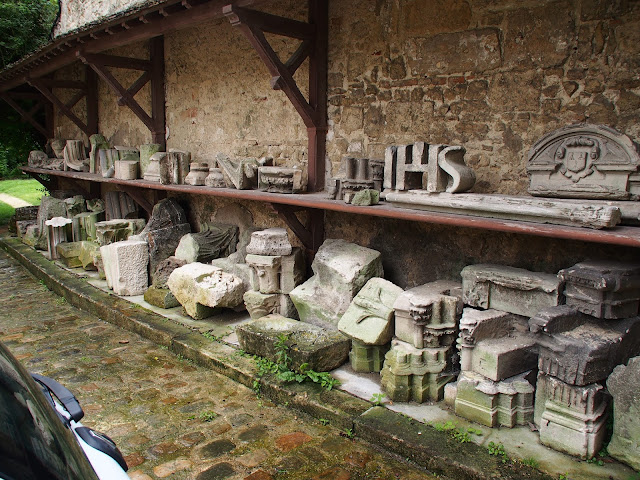 |
| The picturesque rubble from around the city is stored here |
 |
| Gargoyle stored inside |
Attached to the Templar Chapel is the archaeology museum which had some interesting finds. There was a very realistic tombstone of an archbishop, proving that mortal death looks the same for everyone, be them a king, priest or washerwoman.
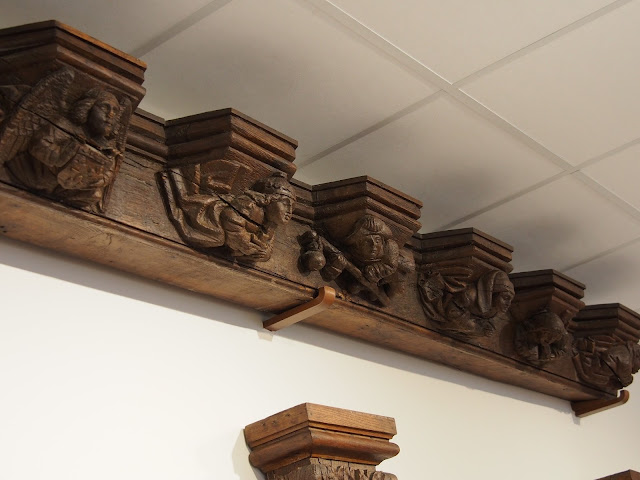 |
| Wooden sculptures from choir stalls |
Walking around Laon proved to be an exciting medieval adventure. Most of the ramparts are still standing, and the three gates that are
still standing are quite impressive. I had a fantastic dinner at a
restaurant in the old town that consisted of foie gras-- my first time
trying it, I could never get over how it was made before, but I decided I
had to at least try it once-- lamb and macaroni confit. It was a real
treat after most of the meals I've eaten, which consist of a combination
of cheese, butter, baguette, salami, tomatoes, and Nutella.
 |
| Peter Abelard was a very well known medieval scholar |
 |
| The tiny street of Peter Abelard |
 |
| Porte d'Ardon |
Finally, on my second day in Laon, it cleared up a bit, and I was able to get some
better pictures. The campground where I was staying was at the bottom of the butte, so it was quite the arduous walk to the medieval city on
top. You had a beautiful view of the valley where the monks used to have vineyards.
The vineyards were abandoned several centuries later after competition from the south.
 |
| The medieval walls still circling the city |
 |
| The walk down the hill from the old town to my campsite |
The city
of Laon had many religious communities. They were all quite rich in their heyday, and several abbeys had their main buildings outside the walls of medieval Laon but maintained a palace-like residence inside the walls for their community during raids and times of war.
 |
| On of the religious order's palatial refuges |
 |
| Another refuge |
I walked by one small church
from the 12th century at the bottom of the hill that was far away from
the medieval town on top of the hill and was supposedly a church for
lepers- no wonder the great distance!
 |
| Chapel of the Old Leper Colony, 12th century |
On the last day, I decided to take
the funicular to the top. My dad has a deep love for funiculars, and I
felt I owed it to him to ride up at least once. It was an enjoyable 90 seconds...
 |
| Funicular to the Old City |
The St Martin's abbey church was just as beautiful as the cathedral in my opinion. It was begun in the 12th century but was continued to be worked one up until the 14th century.
 |
| Saint Martin's abbey church |
 |
| Raoul de Coucy from the 13th century-- I visited his castle later! |
 |
| Saint Joan of Arc |
 |
| Zombie relics |
The farthest medieval gate from the cathedral, the Porte de Soissons, was mostly in ruins but it had been the biggest gate. It was still very cool to see, you could look into the guards' rooms and the vaults on the ceilings. Attached just a little further down the wall was a heavily leaning tower, the Lady Eve tower.
 |
| Ruins of the gate |
 |
| Lady Eve Tower |
On the far edge of the butte, there is a battlement that was built by Napoleon. It
was never used except as a lookout, but all the tunnels are still there
to explore although somewhat dark, wet and creepy.
A children's adventure
course sitting in the shadow of the battalion created the essence of Europe for me: modern life coexisting with– and sometimes overlooking– history's magnificent remains.
Thanks for reading!
Until next time!!






































































































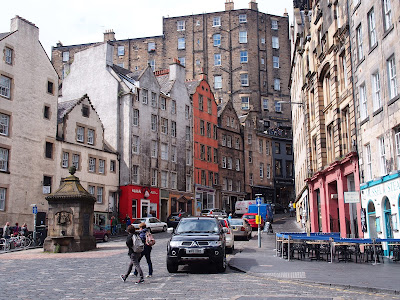
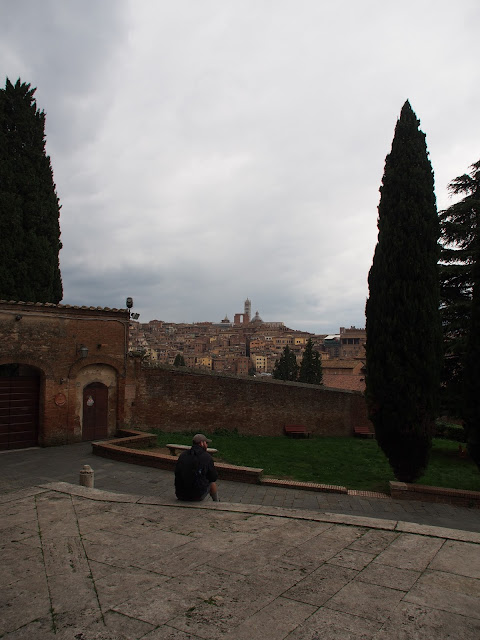



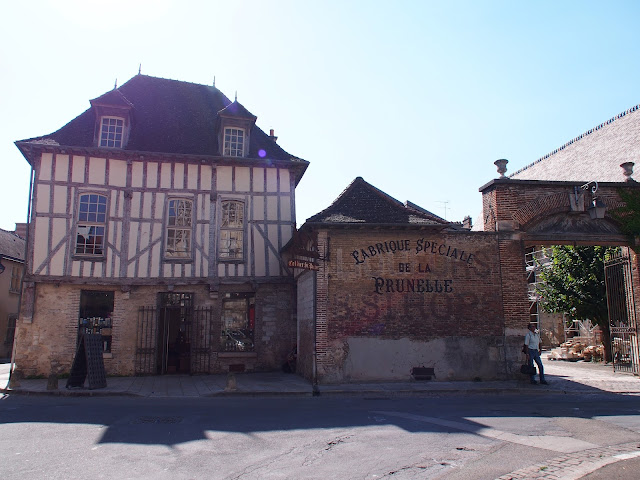


Hello Devon,
ReplyDeleteHello Devon, I am thoroughly enjoying your posts which are like a history lesson and a travelogue combined. As I read, I feel like I am taking this journey with you. Your ability to walk for miles and still have the energy to post beautiful photographs with interesting facts and insights amazes me. I look forward to leaning more. Fondly, Sandra King 11/6/16
ReplyDeleteHello Sandra! It's so nice to hear from you! Yes it definitely took a while until I could walk such long distances though but now I am able to walk forever it seems. I have a whole bunch of posts that I will post as soon as I have the time but right now I'm in Italy and seeing so many beautiful and amazing sights! I hope you and Jerome are doing well. I would love to see you when I return to Bend.
DeleteCheers, Devon